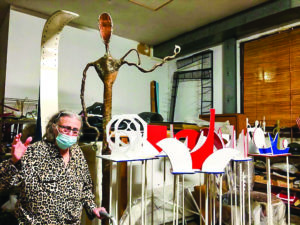
“You can call them ‘Yesterday, Today and Tomorrow,’” said artist Gigi McKendric, standing among several sculptures that ranged from completed faces and abstract figures to works in progress.
When asked for an explanation, she replied, as if it were obvious, “Because they are forever.”
In addition to the striking collection of sculptures, the “they” McKendric referred to include several poems she has written over the years.
McKendric has spent a lifetime creating. She is well known for the faces — fashioned after the faces of people she has met. Some faces were created as commissions. Others were created, she wrote in an introduction to a performance at the War Memorial Art Institute, “as I walked the streets and asked people at random to sit for me.” McKendric began creating masks in 1982, she wrote, “to visualize the inalienable possession of every human being. The metaphysical face that each of us wears.” McKendric’s inspiration is the poet, Rainer Maria Rilke, who wrote that each person wears “several faces.”
McKendric has lived in Baltimore City for more than 30 years, having purchased a $1 home under then-Mayor William Donald Schaefer. The house was an old fire station that she transformed into a work of art, a studio, an exhibit hall. To walk into her home is to be transported into a world of inspired, and continuous, creation.
McKendric’s life has taken her from Romania, to different countries in Europe, to Canada and, finally, to the U.S. In Canada, she studied under the renowned English Canadian painter and educator, Arthur Lismer.
She married a Canadian scientist. They divorced many years ago, after 24 years of marriage. During that time, they lived in various places around the U.S., including in New Jersey and Rhode Island before settling in Baltimore. She has three children, Joanna, an attorney and a dancer; Joshua, who has a law degree and works in finance; and Daniel, a psychologist who, McKendric shared, worked with the survivors of the 2018 Stoneman Douglas High School shooting in Florida.
McKendric reinvented herself after the Holocaust, she said. She was one of the many children of the Holocaust “unwillingly” accepted by Canada between 1947 and 1949. She recalls being 4 or 5 and running with her family after an earthquake decimated her town in Romania, at the height of the Nazi persecution of European Jews. When asked her age, McKendric replied, “I could be 80, 90, 91 or 101.”
McKendric speaks haltingly about her life during the Holocaust, preferring instead to talk about art and the difference she has made in bringing people of all backgrounds together. She worked on planning and documenting the creation of A Living Memorial Park at Nahayarim after seven schoolgirls from Beit Shemesh, Israel, were shot to death by a Jordanian soldier on March 13, 1997.
In honoring the lives of the seven young girls killed, McKendric also sought to create a sacred space so that children from Israel and Jordan can play together “with no border and no soldiers, offering the children the environment to play together and learn respect for each other.” In a nine-hour documentary, McKendric interviewed the families of the victims, as well as some of the children who survived.
McKendric was also a guest at the 58th Japan-American Student Conference at the American University in Washington, D.C., a few years ago, which touched on the subject of conflict and resolution.
Now, she is working on a new collaborative program, one that will bring together her experience as a Holocaust survivor with that of Bill Pedro, an African American musician and coordinator for the local jazz band, Jazzy N Blue. The performance — to be presented via Zoom — is titled, “Traversing a Bridge Towards Achieving Peaceful Coexistence” and will touch on identity, the Holocaust, anti-Semitism and racism. Vin Grabill, former chair of the Visual Arts Department at the University of Maryland, Baltimore County — who worked with McKendric on the Nahayarim documentary — and McKendric’s daughter, Joanna A. Mauer, are also listed on the program.
In a 1993 JT story, Arthur J. Magida writes about touring the U.S. Holocaust Memorial Museum with McKendric.
At the time, McKendric told Magida, “Ask me a reason why some of us were saved. You, I, others. It could have been you. It could have been me. Maybe because those of us who were saved have to do something. That’s about the only answer…I used to say I was a child of the Holocaust because ‘survivor’ wasn’t enough.”






